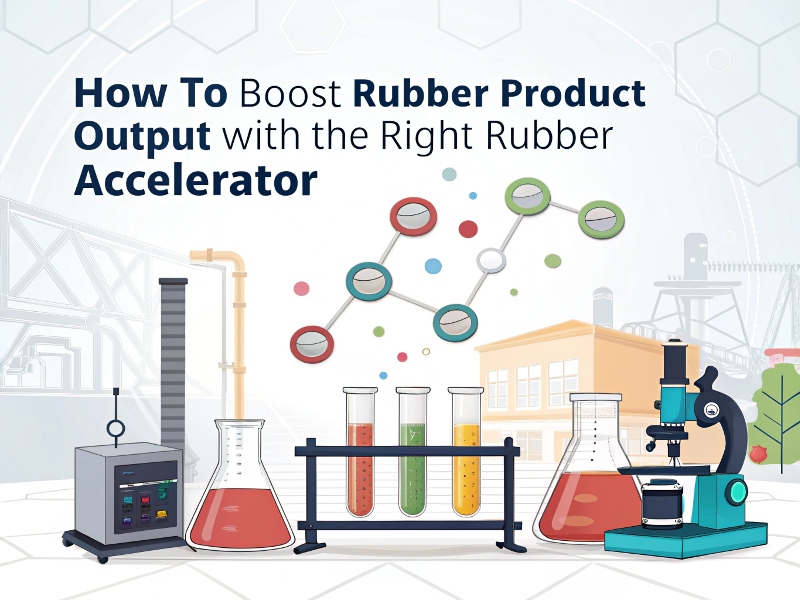
In the highly competitive rubber manufacturing industry, production efficiency is directly linked to profitability. Every manufacturer aims to produce high-quality rubber products in less time while maintaining consistent performance standards. One of the most effective yet often overlooked ways to achieve this is by selecting the right rubber accelerator. By understanding how different accelerators work and matching them with the right compounds, you can significantly enhance production speed, improve quality, and extend the service life of the final product.
Rubber accelerators are chemical agents that speed up the vulcanization process, which is essential for converting raw rubber into a durable, elastic material. The vulcanization process, when carried out without accelerators, can be slow and less efficient. By using the right accelerator, manufacturers can reduce curing time, increase production capacity, and maintain product uniformity. This results in faster turnaround times and better cost efficiency, especially in industries like tyres, footwear, conveyor belts, and molded rubber goods.
How-to-Boost-Rubber-Product-Output-with-the-Right-Rubber-AcceleratorCommon Rubber Accelerators and Their Key Benefits
| Accelerator | Main Benefit | Suitable Rubber Types | Production Impact |
|---|---|---|---|
| MBT | Fast curing at low temperature | NR, SBR, IIR | Speeds up production for general goods |
| MBTS | Balanced curing & scorch safety | NR, SBR, NBR | Ideal for medium-speed tyre manufacturing |
| CBS | Delayed action, high scorch safety | NR, SBR, BR | Allows high-volume processing without defects |
| TMTD | Ultra-fast curing | NR, SBR, EPDM | Best for quick production cycles |
| ZDEC | Very fast, non-discoloring | NR, SBR, latex | Perfect for light-colored or medical goods |
| ZDBC | Fast curing, high activation | NR, CR, latex | Improves output in latex-based manufacturing |
The choice of rubber accelerator depends on several factors such as the type of rubber compound, the desired mechanical properties, curing temperature, and production speed requirements. For example, accelerators like MBT, MBTS, CBS, TMTD, ZDEC, and ZDBC each offer unique advantages in terms of curing rate, scorch safety, and compatibility with different types of rubbers. Fast-acting accelerators can help speed up production, but they may require careful handling to avoid premature vulcanization. On the other hand, delayed-action accelerators provide greater scorch safety, allowing for better processing control in high-volume manufacturing.
Another important aspect is balancing speed and quality. While faster curing can boost output, it should not compromise the tensile strength, elasticity, and resistance properties of the final rubber product. Using the wrong accelerator or incorrect dosage can lead to under-curing or over-curing, both of which reduce product performance and durability. Therefore, manufacturers need to work with experienced chemical suppliers who can recommend the most suitable accelerator based on specific production goals.
Storage and handling also play a crucial role in ensuring consistent accelerator performance. Moisture, heat, and contamination can affect the chemical stability of accelerators, leading to inconsistent curing times. Following proper storage guidelines, such as keeping them in cool, dry environments, helps maintain their effectiveness and ensures that production output remains stable over time.
Additionally, integrating the right accelerator into your rubber compounding process can help reduce energy consumption. Shorter curing cycles mean less heating time, which not only lowers electricity usage but also minimizes wear on machinery. This efficiency can directly translate into reduced operational costs, making your manufacturing process more sustainable and cost-effective.
For manufacturers aiming to expand production capacity without compromising quality, choosing the right rubber accelerator is a strategic decision. It requires an understanding of material properties, process parameters, and the end-use application of the rubber product. By working with a trusted supplier, you can ensure consistent supply, technical guidance, and reliable product performance, all of which contribute to meeting your production targets.
If you are looking to optimize your rubber manufacturing process, reduce production downtime, and enhance overall output, we can provide the right rubber accelerators tailored to your needs. Our range of high-quality accelerators is designed to deliver consistent results, improve curing efficiency, and support large-scale manufacturing operations. With our expertise and reliable supply chain, you can achieve higher productivity and better product quality in every batch.
